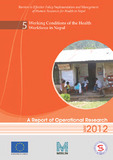Please use this identifier to cite or link to this item:
https://hdl.handle.net/20.500.14356/505| Title: | Working conditions of the health workforce in Nepal |
| Authors: | EUROPEAN UNION MERLIN SOLID/Nepal |
| Citation: | Society for Local Integrated Development Nepal (SOLID Nepal) and Merlin Nepal. Barriers to Effective Policy Implementation and Management of Human Resources for Health in Nepal: Working Conditions of the Health Workforce in Nepal. Lalitpur, Nepal: SOLID Nepal; 2012 |
| Issue Date: | May-2012 |
| Publisher: | SOLID Nepal |
| Keywords: | Health System Nepal |
| Abstract: | Introduction: The low level of motivation among health workers has been identified as a key issue in the current human resources crisis in the health sector. Yet the focus on motivation and performance of health workers through improved working conditions is often overlooked by governments in favour of macroeconomic issues. In Nepal, ensuring a comprehensive strategy that maximises health worker motivation is crucial, particularly in remote areas where the low retention of health workers creates an enormous challenge within the health system. This report examines working conditions of health workers in Nepal in relation to income and incentives, work supplies and equipment, issues on safety and security and the role of local authorities and the community. Methodology: A cross-sectional descriptive study was conducted using mixed method with observation checklist. Fifteen districts representing eco-developmental regions of Nepal were selected using multi-stage cluster sampling method. Out of 404 sample, 747 health workforce from 375 health institutions were interviewed (<10% non-response rate) using the Probability Proportionate to Size method as per WHO guideline. Observation was carried out in 256 health facilities. Further, secondary review was carried out for triangulation of findings. Key Findings: Health workers’ high expectations were not in line with salary provisions or the analysis of average annual savings, which demonstrated that the salary provided to mid-level health workers, was sufficient to meet their basic needs. Government policies do not clearly define the provision of non-financial incentives. The poor management on the provision of living quarter facilities resulted in poor condition and unavailability of such facilities. There is also a clear gap between entitlements stated in government policies and access & availability to these services on the ground. The provision of incentives is hampered by poor quality monitoring systems, which often leads to disputes and de-motivation among staff, as well as undermining efforts to improve maternal and child health. This was highlighted through FGDs, where FCHVs expressed their dissatisfaction with the irregular provision of non-financial incentives and HWs involved in deliveries stated inconsistencies in the process of receiving maternity allowance. Ecological disparities in the working conditions of HWs were found. Lack of career development opportunities and inaccessibility to travel allowance in the Mountain belt were found higher compared to Tarai, where HWs have greater accessibility to amenities and opportunities. The opportunity for private practice was also higher in Tarai, emphasising the importance of effective supervision to ensure that HWs are stationed at their health posts during appropriate working hours. Poor provision of infrastructure, equipment and supplies in health facilities was found to be an issue, particularly in rural areas, and was a contributing factor to low motivation among health staff, poor staff availability and conflict between service users and providers. The key challenge for a well-managed and robust distribution system in remote areas is necessary for improvements in health outcomes. Health Workers perception of security is influenced by local factors, such as conflict with service users within the health institution, as well as more distal factors, such as political instability, which is a barrier to effective HRH management in Tarai. Local authorities are responsible for conflict management, recruitment of local staff and the provision of supplies and equipment, though these systems are often weakened by budget constraints and poor management. Despite the fact that communities are often involved in the provision of non-financial rewards, not all health workers feel that their work is appreciated by the community. The community’s role can therefore be strengthened to provide more support to health workers, particularly in remote areas. Conclusion and Recommendations: Poor work conditions compromise health workforce supply, retention and quality of care. Recommendations focus on improvements in the management of human resources, equipment and supplies, and more robust monitoring systems for incentive-based systems, particularly those related to maternal and child health outcomes. |
| URI: | http://103.69.126.140:8080/handle/20.500.14356/505 |
| Appears in Collections: | Post Graduate Grant (PG) Reports |
Items in DSpace are protected by copyright, with all rights reserved, unless otherwise indicated.

